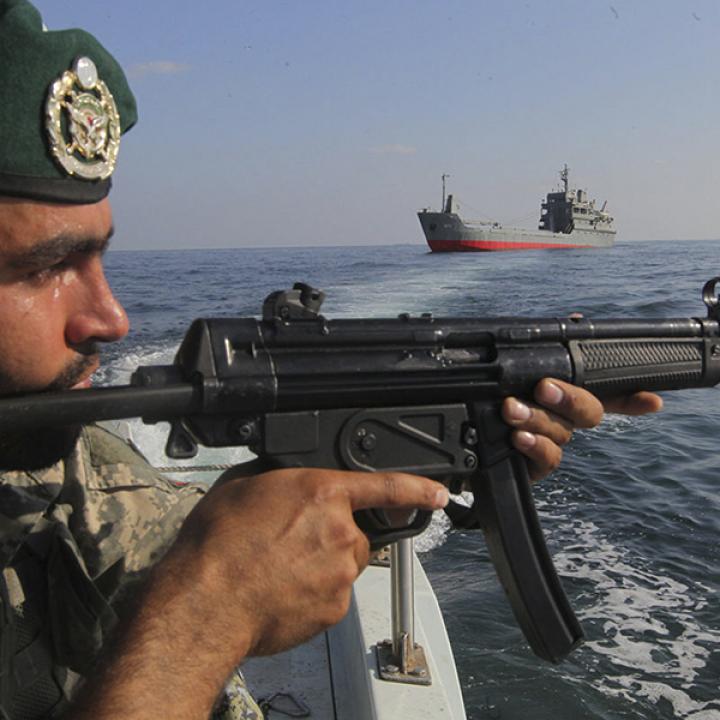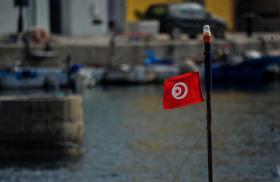
- Policy Analysis
- PolicyWatch 4102
After Snapback, Washington Needs to Prepare for Iranian Escalation in the Gulf

Given Tehran’s long record of using maritime provocations to counter increased international pressure, the United States and its partners must be ready to respond swiftly and forcefully against ship seizures, mine warfare, suicide drones, and more.
With the “snapback” mechanism on UN sanctions recently triggered, Iran is once again threatening to retaliate if heightened international restrictions prevent it from selling enough oil. Last month, the Foreign Ministry spokesman warned of unspecified “consequences” if snapback leads to more sanctions, while various lawmakers and hardline media outlets have threatened strict limits on Persian Gulf shipping traffic linked to France, Germany, the United Kingdom, and the United States, the main parties behind the measure.
Indeed, during similar pressure-packed moments in the past, Iranian retaliation has included a wide range of maritime threats in regional waterways, all of which could imperil America’s main interests there—namely, protecting U.S. personnel, maintaining the flow of hydrocarbons and other commerce, and preserving the stability of Gulf partner nations. To safeguard those interests and deter Tehran, the Trump administration needs a clear strategy that is grounded in past experience and focused on engaging U.S. partners in coordinated measures to counter maritime escalation—with force if necessary.
How Iran Responded to Past Pressure
In May 2019, a few months after the first Trump administration withdrew from the nuclear deal and launched its “maximum pressure” campaign, Iran sabotaged tankers off the Emirati coastal city of Fujairah with limpet mines, highlighting the vulnerability of local energy routes. Iranian attacks continued through the year, from shooting down a U.S. surveillance drone to seizing the British tanker Stena Impero and striking the Saudi oil facilities Abqaiq and Khurais with cruise missiles and drones. Although the United States sent additional assets and forces to Saudi Arabia, this response was viewed as insufficient—both Riyadh and Abu Dhabi questioned whether U.S. red lines were genuine after a vital oil facility was hit without swift retaliation.
Between 2020 and 2023, Washington took numerous other steps to address this threat, such as increasing maritime patrols with Western partners, escorting or “accompanying” thousands of vessels through the Strait of Hormuz, and deploying a new unmanned naval unit (Task Force 59) to monitor shipping lanes. It also captured seven tankers that were illicitly carrying Iranian oil (including the Suez Rajan, whose cargo was eventually offloaded and sold in the United States). These measures foiled some of Iran’s attempted vessel seizures and other attacks, but the regime continued to escalate by launching drones against ships, harassing tankers via small-boat operations, and boosting its support to the Houthis in Yemen. Iranian forces even managed to snatch back the Suez Rajan (renamed St Nikolas) as soon as it returned to the region.
Iranian assistance to the Houthis came to the fore in November 2023, after the Gaza war erupted and the group launched a concerted maritime campaign in solidarity with the Palestinians. Beginning with the Galaxy Leader, Houthi forces regularly tried to hijack, attack, or harass ships with links (real or not) to Israel or the Western coalition, using Iranian-supplied antiship missiles and drones. By year’s end, Western navies were countering daily Houthi attacks, and global shipping companies were forced to detour their vessels around Africa.
Upon taking office this January, the Trump administration labeled Iran a “state-level enabler” of Houthi aggression and warned it to rein in the group. In March, a small U.S.-led coalition launched Operation Rough Rider, a fifty-three-day campaign of strikes against Houthi targets in Yemen. This campaign and the subsequent ceasefire with Washington reportedly halved Houthi missile and drone launches, helping Red Sea shipping traffic rebound to about 60 percent of prewar levels. Yet the strikes did not seem to blunt the Houthis’ attack capabilities or willingness to use them. In July—just two months after the Yemen ceasefire, and two weeks after U.S. and Israeli forces bombed Iran’s nuclear facilities—the Houthis sank two more ships. They also announced a “maritime blockade” of Israel’s Haifa port and launched further salvos of ballistic missiles and drones in that direction.
In short, international military deployments and sanctions have only partially bolstered deterrence. Houthi attacks continue, and Iran is still engaging in major efforts to arm the group with advanced weapons while supporting or directly carrying out various forms of maritime coercion. Although coalition actions—including through the Combined Maritime Forces (CMF) framework—have helped stabilize the region’s waterways for years, gaps persist. More recent multilateral mechanisms have sought to bolster this effort, such as the International Maritime Security Construct (IMSC)/Coalition Task Force Sentinel (stood up in 2019), Operation Prosperity Guardian (2023), and the EU’s Operation Aspides (2024). But international partners have yet to concentrate enough capabilities and resolve to deter the Houthis and Tehran from escalation. Moreover, key Red Sea states such as Egypt and Saudi Arabia have been unwilling to fill in any gaps or participate in military operations aimed at securing that route.
Will Snapback Trigger a Maritime Conflict?
Now that snapback has been triggered, the risks of escalation in the Persian Gulf are high. In such a scenario, Iran would likely refrain from large-scale moves such as trying to close the Strait of Hormuz, despite public bluster to that effect. Instead, it would presumably opt for disruptive acts first, such as ship seizures, forceful boarding and searching of vessels, selective denial of passage, and sporadic covert mining or drone attacks. The aim would be to raise oil prices to offset its lost exports, unsettle Washington, and rally domestic audiences—but without provoking coalition strikes on its territory.
The recently quiet Islamic Revolutionary Guard Corps Navy (IRGCN)—rather than Iran’s regular navy—should be expected to take the lead in any such escalation. At first, the force would likely keep most of its speedboat units tucked away and rely more on land-based ballistic and cruise missiles and drones for calibrated strikes against vessels, oil terminals, and/or military bases in the region. Such an approach would presumably follow Iran’s proven playbook of conducting asymmetric operations that make full use of its geographical advantages and dispersed resources. The main difference now is that the United States and its allies have complete control of the air and information domains. Knowing this, the IRGC can be expected to encourage Houthi proxy attacks in order to complicate U.S. movements and strain regional defenses. Yet this would put the Houthis in a difficult position considering their bilateral truce with Washington.
Gulf escalation would also test the strength of U.S. regional coalitions. If Iran starts seizing more ships or increasing its other harassment activities, Gulf states may hesitate to join visible enforcement operations for fear of retaliation against their ports, cities, mega-projects, or offshore energy assets. This would leave the United States and a handful of Western navies to shoulder a burden that they cannot sustain indefinitely without straining their force structure in other parts of the world. Unless managed carefully, this unbalanced dynamic could erode coalition credibility, undermine deterrence, embolden Iran to exploit coalition gaps, and reinforce perceptions that U.S. security commitments in the Middle East are transactional and finite.
Policy Recommendations
Given the major interests at stake, the United States should maintain a resolute high-, medium-, and low-end naval presence in the region with access to both the Persian Gulf and the Red Sea—perhaps a carrier strike group and Flight III Aegis destroyers with track-on-remote and launch-on-remote capabilities to engage ballistic targets at greater ranges more quickly. It should also prepare to counter potential vessel seizures by deploying escorts equipped with helicopters, drones, rapid-response teams, and well-rehearsed ship-to-ship communications. The U.S. military once considered putting armed Marines aboard merchant ships transiting the Strait of Hormuz for protection; it may be time to revisit that idea.
Mine warfare will also be critical in any future Gulf crisis. The U.S. Navy has four Avenger-class minehunters in the Persian Gulf (two retiring soon) and one littoral combat ship (LCS) with a mine-countermeasures package. To avoid a capability gap, it needs to accelerate the scheduled deployment of two more LCS platforms. These countermeasures should be reinforced with forward-deployed aviation teams (uncrewed and crewed), survey ships, pre-surveyed alternate routes, and regular minesweeping drills.
Regarding missile threats, Washington should draw a clear red line: if Iran or its proxies launch any antiship missiles (cruise, ballistic, or hypersonic) near shipping lanes, immediate U.S. strikes will be triggered against the launch sites and command nodes. At the same time, accelerated U.S. efforts to build an advanced, integrated missile defense network in the Gulf region are vital to counter Iran’s expanding arsenal of missiles and suicide drones, which threaten not only U.S. forces, but also the economic infrastructure and civilian populations of America’s partners. Of particular use would be a Gulf-wide, real-time architecture powered by artificial intelligence, with digitally linked radars, sensors, and pooled interceptors. In addition, offshore energy infrastructure should be hardened with persistent surveillance, point defenses, and visible protection drills.
In the Red Sea, combined task forces should establish swifter strike-response cycles for whenever the Houthis attack, and do what is necessary to interdict Iranian arms shipments to Yemen more rigorously. Yemeni forces are already playing a more active role in the latter task, so Washington and its Gulf partners should help them improve and expand their interdiction capabilities. At the same time, more cautious coalition partners should be permitted to play quieter roles while a few committed states handle high-profile enforcement.
Meanwhile, Washington should keep backchannels open to Tehran, warning that any maritime escalation after snapback could trigger a variety of unpredictable measures, from capturing tankers laden with Iranian oil to launching major strikes on the regime’s naval and missile assets. The United States should not shy away from escalation when necessary, whether to deter Iranian actions in the first place or control the escalation ladder if deterrence fails.
In military terms, the United States and its partners are more than capable of containing potential disruptions, hardening key nodes, and drawing clear red lines. The hardest challenge remains political: persuading cautious Gulf states to contribute more to the security of their own littorals.
Farzin Nadimi is a senior fellow at The Washington Institute, specializing in the security and defense affairs of Iran and the Persian Gulf region.



